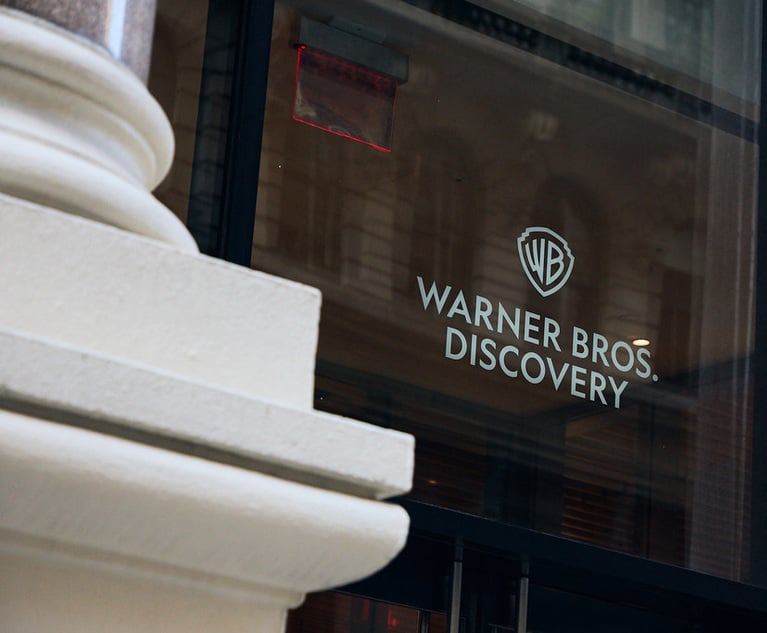IP: Keyword Advertising
Unauthorized use of trademarks in keywords can be an actionable infringement.
April 18, 2011 at 08:00 PM
5 minute read
The original version of this story was published on Law.com
 Whether a company can safely purchase search engine keywords identical to the trademarks of its competitors is an open question being hotly debated in the courts. A keyword is a purchased search term that generates an advertisement from the keyword purchaser when entered into a search engine by an Internet user.
Whether a company can safely purchase search engine keywords identical to the trademarks of its competitors is an open question being hotly debated in the courts. A keyword is a purchased search term that generates an advertisement from the keyword purchaser when entered into a search engine by an Internet user.
A finding of trademark infringement under the federal Lanham Act requires initial findings that the defendant “has used the plaintiff's mark in connection with the sale or offering for sale of goods or services” and the use was made “in commerce.” The threshold question of whether a keyword purchase constitutes actionable use of a trademark under the Lanham Act was unsettled until relatively recently, but a clear majority of courts have now concluded that the unauthorized use of trademarks as keywords is actionable use.
A determination of trademark infringement, however, also requires a showing that the unauthorized use of the trademark is likely to cause confusion among consumers in the marketplace. In this regard, the 9th Circuit Court of Appeals' March 8, decision, in Network Automation, Inc. v. Advanced Systems Concepts, Inc., is instructive. By way of background, the litigants Network and Advanced Systems sell competing software. Network markets its software under the AutoMate trademark and Advanced Systems markets its competing product under the trademark ActiveBatch. To advertise its product online, Network purchased the keyword “ActiveBatch” from Google and Microsoft Bing. As a result, when consumers searched for “ActiveBatch” on Google and Microsoft Bing, the search results would include Network's advertisement and a link relating to Network's competing product. Network's advertisement appeared on a partitioned section of the screen labeled “sponsored” results.
Advanced Systems objected to this use of its ActiveBatch trademark and Network responded to Advanced Systems' cease and desist letters by filing an action in federal court requesting a judicial declaration of non-infringement. Advanced Systems counterclaimed alleging trademark infringement under the federal Lanham Act and moving for a preliminary injunction. The district court granted the preliminary injunction finding that Networks' use of its competitor's ActiveBatch mark as a keyword caused initial interest confusion among consumers.
On appeal, the 9th Circuit vacated the preliminary injunction and provided guidance regarding the likelihood of confusion analysis in keyword trademark infringement disputes. The court explained that the most important factors are: strength of the allegedly infringed trademark; evidence of actual confusion; the type of goods at issue and the degree of care likely to be exercised by the consumers of such goods.
According to the court, the degree of care factor likely cuts against Network, “[a] sophisticated consumer of business software exercising a high degree of care is more likely to understand the mechanics of Internet search engines and the nature of sponsored links, whereas the un-savvy consumer exercising less care is more likely to be confused.” The court took care to note that the ever-increasing sophistication of Internet shoppers, in general, affects the analysis by reducing the likelihood that they will be confused in a keyword case, stating that “the default degree of consumer care is becoming more heightened as the novelty of the Internet evaporates and online commerce becomes commonplace.”
Meanwhile, the court also guided that similarity of marketing channels is of less relevance in keyword disputes because most commercial retailers operate in the online marketing channel and the “shared use of a ubiquitous marketing channel does not shed much light on the likelihood of confusion.”
While the foregoing factors are familiar aspects of the likelihood of confusion tests in trademark cases, the 9th Circuit indicated that the lower court should have considered additional issues in a keyword dispute. For example, the Court of Appeals noted the labeling, appearance and context of the keyword advertising in the search results is critical, stating “here, even if Network has not clearly identified itself in the text of its ads, Google and Bing have partitioned their search results pages so that the advertisements appear in separately labeled sections for 'sponsored' links. The labeling and appearance of the advertisements as they appear on the results page includes more than the text of the advertisement and must be considered as a whole.”
Indeed, whether the litigants' goods are closely related may be of less importance where labeling is clear, “if advertisements are clearly labeled or consumers exercise a high degree of care . . . rather than being misled, the consumer would merely be confronted with choices among similar products.” The district court's grant of the preliminary injunction was an abuse of its discretion because it failed to consider the heightened care of the relevant consumers, the context of the accused advertisements and to properly weigh the confusion factors.
The 9th Circuit's decision in Network indicates judicial skepticism on whether an advertiser's use of its competitor's trademarks in keyword advertising will create consumer confusion. The “labeling, appearance and context” considerations may make a finding of liability less likely where the keyword advertisement is displayed in a separate “sponsored results” section, which is a common search engine format. However, this decision should not be read overly broadly. The Court did not say that keyword advertisements in “sponsored results” could never result in infringement. Moreover, the use of trademarks as keywords is hotly contested in multiple circuits. For example, the 4th Circuit Court of Appeals will soon indicate its views in Rosetta Stone Ltd. v. Google, Inc. Because the likelihood of confusion analysis is heavily dependent on the particular facts of each dispute, whether a company can safely use a competitor's trademark as a keyword search term is a determination that should be made with the advice of a trademark attorney.
Read Christopher Dolan's previous column. Read Christopher Dolan's next column.
This content has been archived. It is available through our partners, LexisNexis® and Bloomberg Law.
To view this content, please continue to their sites.
Not a Lexis Subscriber?
Subscribe Now
Not a Bloomberg Law Subscriber?
Subscribe Now
NOT FOR REPRINT
© 2025 ALM Global, LLC, All Rights Reserved. Request academic re-use from www.copyright.com. All other uses, submit a request to [email protected]. For more information visit Asset & Logo Licensing.
You Might Like
View All


SEC Puts Beat Down on Ex-Wrestling CEO Vince McMahon for Not Reporting Settlements
3 minute readTrending Stories
- 1'It's Not Going to Be Pretty': PayPal, Capital One Face Novel Class Actions Over 'Poaching' Commissions Owed Influencers
- 211th Circuit Rejects Trump's Emergency Request as DOJ Prepares to Release Special Counsel's Final Report
- 3Supreme Court Takes Up Challenge to ACA Task Force
- 4'Tragedy of Unspeakable Proportions:' Could Edison, DWP, Face Lawsuits Over LA Wildfires?
- 5Meta Pulls Plug on DEI Programs
Who Got The Work
Michael G. Bongiorno, Andrew Scott Dulberg and Elizabeth E. Driscoll from Wilmer Cutler Pickering Hale and Dorr have stepped in to represent Symbotic Inc., an A.I.-enabled technology platform that focuses on increasing supply chain efficiency, and other defendants in a pending shareholder derivative lawsuit. The case, filed Oct. 2 in Massachusetts District Court by the Brown Law Firm on behalf of Stephen Austen, accuses certain officers and directors of misleading investors in regard to Symbotic's potential for margin growth by failing to disclose that the company was not equipped to timely deploy its systems or manage expenses through project delays. The case, assigned to U.S. District Judge Nathaniel M. Gorton, is 1:24-cv-12522, Austen v. Cohen et al.
Who Got The Work
Edmund Polubinski and Marie Killmond of Davis Polk & Wardwell have entered appearances for data platform software development company MongoDB and other defendants in a pending shareholder derivative lawsuit. The action, filed Oct. 7 in New York Southern District Court by the Brown Law Firm, accuses the company's directors and/or officers of falsely expressing confidence in the company’s restructuring of its sales incentive plan and downplaying the severity of decreases in its upfront commitments. The case is 1:24-cv-07594, Roy v. Ittycheria et al.
Who Got The Work
Amy O. Bruchs and Kurt F. Ellison of Michael Best & Friedrich have entered appearances for Epic Systems Corp. in a pending employment discrimination lawsuit. The suit was filed Sept. 7 in Wisconsin Western District Court by Levine Eisberner LLC and Siri & Glimstad on behalf of a project manager who claims that he was wrongfully terminated after applying for a religious exemption to the defendant's COVID-19 vaccine mandate. The case, assigned to U.S. Magistrate Judge Anita Marie Boor, is 3:24-cv-00630, Secker, Nathan v. Epic Systems Corporation.
Who Got The Work
David X. Sullivan, Thomas J. Finn and Gregory A. Hall from McCarter & English have entered appearances for Sunrun Installation Services in a pending civil rights lawsuit. The complaint was filed Sept. 4 in Connecticut District Court by attorney Robert M. Berke on behalf of former employee George Edward Steins, who was arrested and charged with employing an unregistered home improvement salesperson. The complaint alleges that had Sunrun informed the Connecticut Department of Consumer Protection that the plaintiff's employment had ended in 2017 and that he no longer held Sunrun's home improvement contractor license, he would not have been hit with charges, which were dismissed in May 2024. The case, assigned to U.S. District Judge Jeffrey A. Meyer, is 3:24-cv-01423, Steins v. Sunrun, Inc. et al.
Who Got The Work
Greenberg Traurig shareholder Joshua L. Raskin has entered an appearance for boohoo.com UK Ltd. in a pending patent infringement lawsuit. The suit, filed Sept. 3 in Texas Eastern District Court by Rozier Hardt McDonough on behalf of Alto Dynamics, asserts five patents related to an online shopping platform. The case, assigned to U.S. District Judge Rodney Gilstrap, is 2:24-cv-00719, Alto Dynamics, LLC v. boohoo.com UK Limited.
Featured Firms
Law Offices of Gary Martin Hays & Associates, P.C.
(470) 294-1674
Law Offices of Mark E. Salomone
(857) 444-6468
Smith & Hassler
(713) 739-1250







